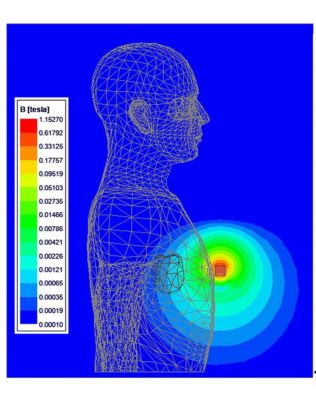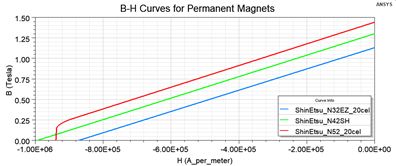-
United States -
United Kingdom -
India -
France -
Deutschland -
Italia -
日本 -
대한민국 -
中国 -
台灣
-
-
產品系列
查看所有產品Ansys致力於為當今的學生打下成功的基礎,通過向學生提供免費的模擬工程軟體。
-
ANSYS BLOG
May 10, 2021
Simulate How Permanent Magnets Impact Medical Implants
Fig. 1. Side view of field overlay plot on Human body, heart, and magnet
Many people who have medical implants like pacemakers are instructed to maintain a certain distance from magnetic fields that may affect or interfere with these life-saving devices. Leakage fields around permanent magnets in modern consumer electronic devices like phones, laptops and tablets may extend to unwanted areas, if not contained by shielding.
Magnetic field sources may come from many places with various strengths. For example, the Earth’s magnetic field ranges near 30 microtesla mT, which is very small. Permanent magnets may have fields at their surface near 1 Tesla – large enough to cause issues with some electronic devices. Some permanent magnets are used in consumer electronics devices for purposes of latching or aligning wireless charging coils. However, they carry certain risks, depending on their proximity to sensitive medical devices.
The fringing pattern around a permanent magnet will depend on its strength, size and the amount of ferrous material in close proximity, which in turn impacts the field strength at different distances and orientations of the magnets. When designing consumer electronics with permanent magnets, it is important to assess the fringing pattern near medical devices.
Evaluate Magnetic Fields for Biomedical Applications
Using Ansys Maxwell, you can define arbitrary magnet assemblies and evaluate magnetic fields in 3D space. You can evaluate the fields at different positions using a human body model, benefitting from automatic adaptive meshing in Maxwell to achieve an accurate, efficient and appropriate mesh for any geometric combination. Creating a design of experiments for position or rotation of the magnet assembly allows you to study resulting field strength near the medical device in question. This allows you to investigate different magnetic architectures, evaluate magnetic shielding options or develop guidelines for acceptable distances the magnets should be kept from the medical device.
Fig. 2 (left): Front and side views of Human body, heart, and magnet models. Fig. 3 (right): Magnetization direction in magnets
The examples shown here use a Halbach magnet array, a special arrangement of magnetization patterns to both enhance and cancel magnetic fields in different areas of the magnet as shown in Fig.3. First, we set up a parametric sweep for the distance between the heart and the magnet array as well as the grade of magnet material. We define a variable of distance as “distance_x,” sweeping from +20 mm to -20 mm, representing a distance far from and close to human heart model.
Three grades of magnet materials are swept including “ShinEtsu_N32EZ_20cel,” “ShinEtsu_N42SH-R_20cel” and “ShinEtsu_N52_20cel.”
Plotting the magnitude of the B field versus distance and magnetic grades shows quantitatively how the magnet field around human heart decays for different magnet materials as the permanent magnet is moved further away from the heart.
Fig. 4. B-H curves for permanent magnets
Fig. 5. Average flux density in heart vs. distance between heart and magnet and magnetic grades
Field overlay plots enable visualization of the fields around human body. The amination of field overlay plots intuitively shows the changing of magnetic flux density around heart with respect to the location of the permanent magnet.
Fig. 6. Side and top views of field overlay plots of flux density in heart vs. distance between heart and magnet
Understanding the interaction of magnetic fields that result from permanent magnets used in consumer electronics and sensitive medical devices can be achieved using Maxwell. This gives you vital information about the strength of magnetic fields from magnet assemblies, as well as the fields medical devices are exposed to.
Watch this webinar to learn more about low-frequency electromagnetic solutions that help drive the design of biomedical devices.














